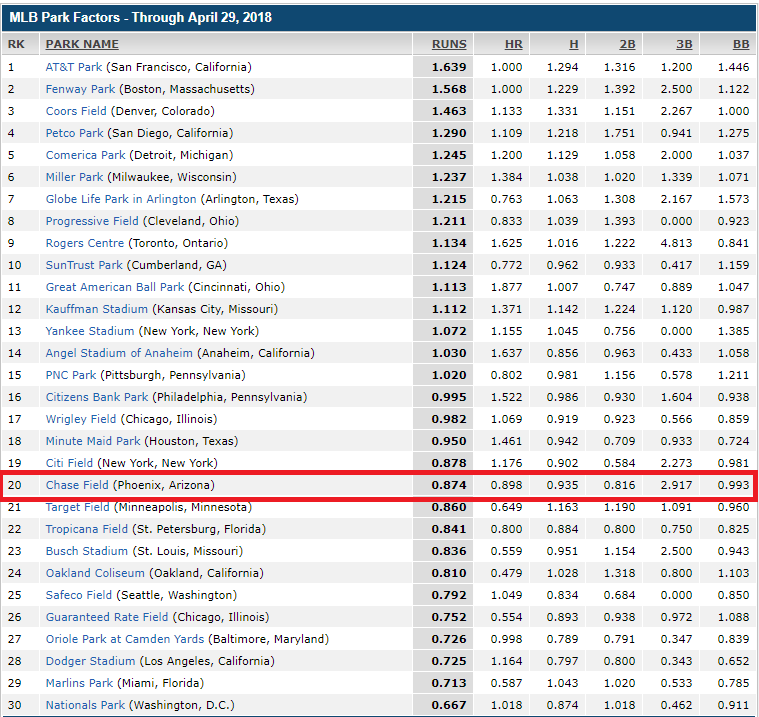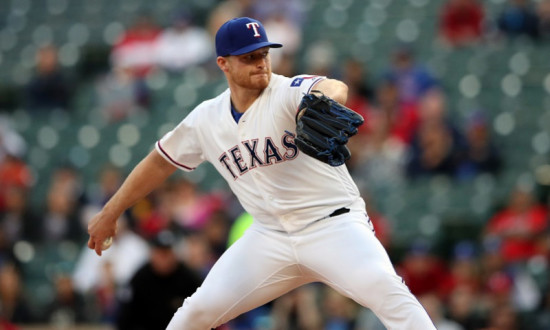2018 MLB Risers and Fallers: Volume 2
Welcome back to another season of Risers & Fallers! Last year in this space, I turned you onto first-half Alex Wood because of his increased velocity and incredible curveball pitch tunneling. I told you Justin Verlander would be fine. I told you Seth Lugo’s insane curveball spin rate didn’t make him a good pitcher and that Aaron Nola’s low swinging strike percentage didn’t matter.
This is where I dive deep into the numbers and the narratives and see what’s real and what isn’t using advanced metrics, my DFS projection system (THE BAT, available in the RotoGrinders Marketplace), and insights from my scouting background. I’ll examine guys whose stock is going up, guys whose stock is going down, guys who are perpetually underpriced or overpriced, guys who are worth paying a premium for, or guys who are just interesting and warrant some analysis on.
Rising…
Arizona Diamondbacks Pitchers, and Belief in the Humidor Effect
If your attention gets diverted by football and basketball during the winter months, you may not have heard the word “humidor” until the first weekend of baseball season when 27 runs were scored in the first two games at Chase Field and anti-science Twitter took that as a directive to go on an all-you-can-troll spree.
So what’s this all about? Well, over the off-season the Arizona Diamondbacks announced they would be adding a humidor to Chase Field in an attempt to make the balls easier for their pitchers to grip. The side-affect, according to all of the scientific and mathematical evidence, was that Chase Field would go from the second-best hitters’ park in baseball to a full-on pitchers’ park. For anyone who doesn’t care much for math or science (and after this off-season, I can say from personal experience that there are way more of these people out there than I ever thought possible), this sounded like an outrageous claim. How could that possibly be true?
I posted a Twitter thread during the winter that got very popular that broke down all the evidence in very simple terms.
/THREAD
— Derek Carty (@DerekCarty) February 14, 2018
MUST READ: Everything you need to know about the Chase Field humidor and why Chase will become a pitchers’ park in 2018
I highly recommend reading this thread in its entirety, but I’ll quickly summarize the evidence here as well.
1) Coors Field has a humidor, and after it was added offense declined significantly.
This was unknown by many people since Coors Field is such an elite hitters’ park to this day. But as good as it is now, it was wayyyyy better before adding the humidor. After adding the humidor, Coors offense declined quite a bit:

Unlike Coors Field, though, Chase did not project to stay an elite hitters’ park. Coors has 5 times the elevation of Chase, which means much thinner air that still makes it play extremely hitter-friendly. If you applied the Coors drop-off factors directly to Chase, however, it would go from the 2nd-best to just the 15th best hitters’ park in baseball (i.e. neutral).
2) The world’s leading baseball physicist predicted an even greater drop-off for Chase than we saw in Coors.
Because Arizona (16% average relative humidity) is less humid than Coors (36%) to begin with, balls should absorb even more water in the humidor in Arizona, causing them to be even heavier and less bouncy than the balls used in Coors. As a result, Dr. Alan Nathan predicted a home run drop-off in Chase Field of 37%, on average, with a range between 25% and 50%.
3) Using Statcast, Andrew Perpetua also found the drop-off in Chase would be huge.
Andrew is the creator of xStats and one of the leading Statcast analysts, and his work at FanGraphs helped solidify our expectations.
…
I’m still absolutely baffled at how all this wasn’t compelling enough for so many people. We have a previous, tangible example of a huge drop-off following the addition of a humidor and the smartest man in the public sector when it comes to baseball physics saying that this will happen. But the cognitive bias of “how could something change so drastically so quickly” was strong.
We’re a month into the season now, and while a month-long sample of park factor data is still extremely noisy and barely more important, in a practical sense than the two-game sample people overreacted to early on, it’s worth taking a look at what has happened so far and reviewing the evidence for anyone who isn’t yet convinced that the humidor is a real thing. Here are ESPN’s Park Factors with Chase’s position highlighted:

After a month of baseball is in the books, Chase Field sits as the 20th best hitters’ park in baseball—i.e. a pitchers’ park. Of course, AT&T is number one, and there’s no way that continues. There’s noise involved, but it’s still worth noting that Chase is exactly where we thought it would be.
One of my former Baseball Prospectus colleagues and now the face of MLB’s Statcast, Mike Petriello, dug deeper to present some data on batted balls in Chase Field.
The season’s only a month old, yet the effects of the humidor in Arizona seem (so far) pretty clear. It’s a big deal. Science wins again.
— Mike Petriello (@mike_petriello) April 30, 2018
MORE -> https://t.co/AiDKotcmqN pic.twitter.com/gtoEuZomBN
Unsurprisingly, exit velocity is way down in Chase Field, more than we could chalk up to random variance alone. In his full article, Mike summarizes it perfectly:
Furthermore, [Dr. Nathan] noted that in 2015-16, D-backs hitters away from home had exit velocities 2 mph lower than they did in Arizona, and that a purely physics-based calculation suggested exit velocities might drop by as much as 4 mph.
So that’s our baseline, based on science and observation: Home runs down by 25-50 percent, and exit velocity down by approximately 2-4 mph. What’s actually happened?
If we compare the first 12 games of this year in Arizona (both teams) to the first 12 games of the previous two seasons there, we see a clear change. We see almost exactly what was predicted.
Exit velocity has dropped by 2.7 mph, which fits perfectly. Exit velocity only on fly balls and liners has dropped by a full 3 mph. Home runs per game are down… nearly 30 percent. Runs per game are down, considerably. Hard-hit rate, defined as balls hit 95 mph or harder, has dropped by six points. The ball is simply not being hit as hard this April in Arizona as compared to either of the last two.
Not only is the noisy park factor data saying Chase has been a pitchers’ park this year, but the less-noisy Statcast data is saying the same thing.
We’re only a month into the year, and I want to be clear that this is NOT a victory lap. The whole concept of victory laps on something like this seems asinine to me. All the evidence points in one direction. So either you take the high probability play of believing what all the math and science and people smarter than you say, or you pretend like you’re smarter than all of these people and all of this evidence with literally nothing to support your stance. It’s a month in and nothing is definitive yet, but regardless of what ultimately happens, there’s really only one rational prediction here.

So what happened over those first couple games when 27 runs were scored and science was prematurely declared dead? The easiest answer is random variance. Park factors are extremely noise. Even over a full season, park factors still have a ton of noise. It’s also possible that the balls hadn’t reached an equilibrium in storage yet. I don’t believe we ever heard when the first set of balls were placed in the humidor or when it was turned on, but balls in a humidor need time to absorb water from the air. It’s not as simple as the D-backs flipping a switch and now all of a sudden the baseballs are different. It takes time. Days, maybe weeks. Maybe those first few games used balls with different properties than we’d expect from balls sitting in a humidor for a longer period of time. This is pure speculation, and random variance is still the most likely explanation, but I suppose it’s possible.
Either way, all the evidence — both the evidence from before the season and the admittedly small-sample evidence after a month of 2018 — continues to point in one direction: the humidor is very real and should make Chase Field a pitchers’ park going forward.
Fade science at your risk.